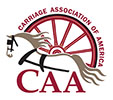
A. So far as I know, the word limousine did not come into use in the English language before the coming of the automobile. However, a horse-drawn limousine was a type of carriage in France and the following description is from the French carriage trade journal, “Le Guide du Carrossier” of 1903.
“Named for the region where it originated (Limousine in South Central France), it is a two-wheeled cart with tow forward-facing seats, enclosed with paneled – top and sides like a fourgon (luggage van). In the country it is used to carry people, but elsewhere its use is modified. In Paris, for example, it serves as a delivery vehicle for grocers, milkmen, etc.”
A distinctive feature of the horse-drawn Limousine was the roof that extended forward over the driver’s seat like a Rockaway in this country. When some French motorcar builders made a body with a fully-enclosed passenger compartment, but with only an extension of the roof to protect the driver, he gave it the name “limousine.” Since many American carriage builders copied designs from Europe, mostly from France, the name was adopted here about 1902 or earlier.
French dictionaries give another meaning for the word “limousine,” i.e. a wagonner’s or shepherd’s course woolen cloak, but it seems unlikely that so humble, and probably odoriferous, an article could have any association with those stately, gleaming conveyances we now know by that name.
M.S.T.
From The Carriage Journal, Vol. 21, No 3, Winter 1984
